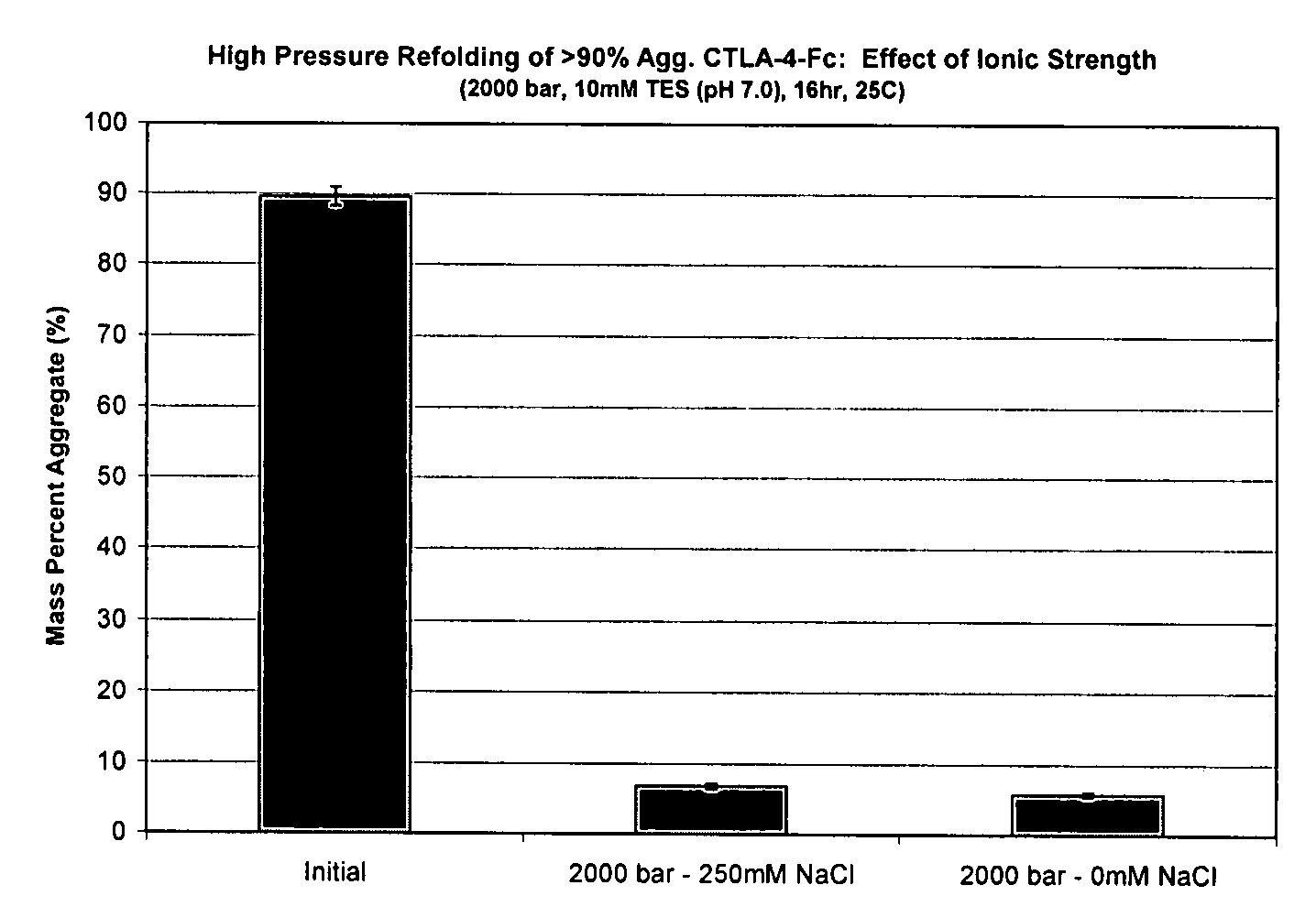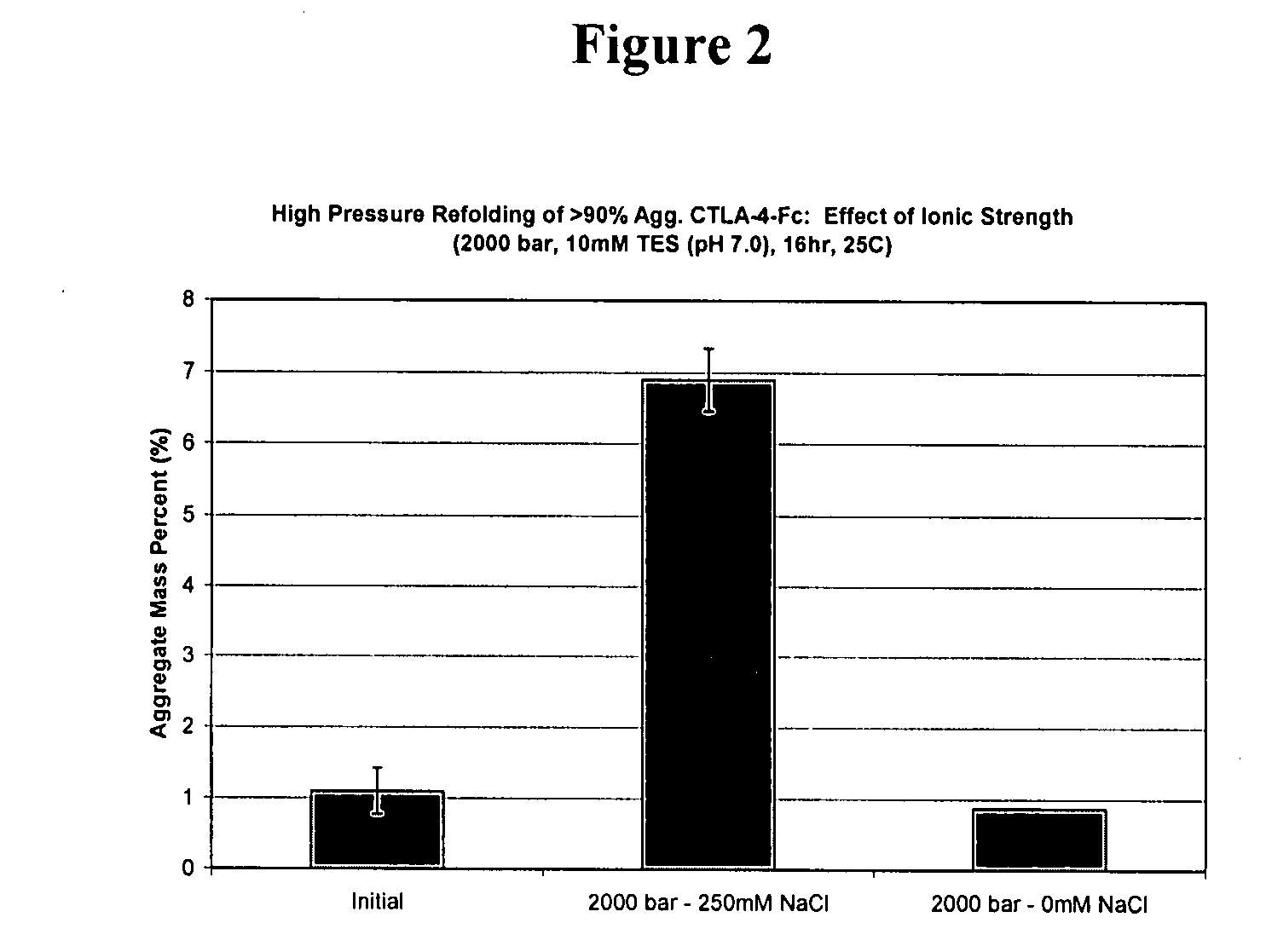High pressure treatment of proteins for reduced immunogenicity
a technology of immunogenicity and protein, applied in the field of recombinant proteins, can solve the problems of difficult identification of conditions that completely stabilize monomers, and achieve the effects of reducing immunogenicity, increasing bioactivity, and reducing immunogenicity
- Summary
- Abstract
- Description
- Claims
- Application Information
AI Technical Summary
Benefits of technology
Problems solved by technology
Method used
Image
Examples
example 1
CTLA-4-Ig Aggregate Reductions
[0143]High pressure treatment of preparations with high monomer content under conditions identical to treatment of preparations of the same protein with high aggregate content leads to very different results. Studies have been conducted with CTLA-4-Ig that demonstrate effective refolding yields of solutions comprising >90% aggregates at 2000 bar, pH 7, at high and low ionic strength, with final aggregate compositions of 7% and 6% respectively. Monomer treated at high pressure (2000 bar) at low ionic strength maintained its native structure and size (1% aggregate). However, monomer treated at high pressure resulted in pressure induced aggregation, having a final composition of 7% aggregate. Therefore, refolding a sample that contained less than 90% aggregate cannot simply mimic conditions that are effective for refolding a solution with >90% aggregate. These results have a direct implication on immunogenicity concerns, since solutions after downstream pu...
example 2
Recombinant Human Growth Hormone (rhGH) Refolding Studies
[0151]Studies were undertaken to determine “best case” conditions for refolding of recombinant human growth hormone (rhGH) for use in subsequent studies on the immunogenicity of rhGH (see the Example entitled “Recombinant human growth hormone (rhGH) refolding studies” below). Investigations by St. John et al. have demonstrated that rhGH is sensitive to aggregation by shaking (St. John, R. J., J. F. Carpenter, et al. (2001), Journal of Biological Chemistry 276(50): 46856-46863). Two types of aggregates were generated by gentle agitation in formulation buffer or formulation buffer containing 0.75M guanidine HCl (ibid). Formulation buffer was defined as 10 mM Na Citrate (pH 6.0), 1 mM EDTA, 0.1% sodium azide and the resulting aggregated rhGH solutions were found to contain >90% aggregates (ibid). High pressure refolding studies were conducted to determine the effect of pressure, temperature, and guanidine HCl concentration on the...
example 3
Recombinant Human Growth Hormone (rhGH) Immunogenicity Studies
[0155]Studies were conducted to determine the effect of aggregates before and after high pressure treatment on the immunogenicity response in naïve mice dosed with varying forms of rhGH, in a similar immunogenicity model taught by Braun et al. (Braun et al., Pharmaceutical Research, v14, pg. 1472-1478, 1997).
[0156]rhGH samples were produced from Nordiflex (a liquid formulation of rhGH manufactured by NovoNordisk). 15 mg vials of Nordiflex were purchased from the University of Colorado apothecary. The rhGH was diluted to a concentration of 1 mg / ml. The diluent used was one of two conditions: (1) the formulation buffer or (2) formulation buffer without pluronic F-68. The Norditropin formulation buffer contains 1.7 mg histidine, 4.5 mg pluronic F-68, phenol 4.5 mg, mannitol 58 mg in 1.5 ml of water as a diluent. The diluted samples were then either shaken (described as “Shaken”) or stressed using freeze-thaw cycles (describe...
PUM
| Property | Measurement | Unit |
|---|---|---|
| pressure | aaaaa | aaaaa |
| pressure | aaaaa | aaaaa |
| pH | aaaaa | aaaaa |
Abstract
Description
Claims
Application Information
 Login to View More
Login to View More - R&D
- Intellectual Property
- Life Sciences
- Materials
- Tech Scout
- Unparalleled Data Quality
- Higher Quality Content
- 60% Fewer Hallucinations
Browse by: Latest US Patents, China's latest patents, Technical Efficacy Thesaurus, Application Domain, Technology Topic, Popular Technical Reports.
© 2025 PatSnap. All rights reserved.Legal|Privacy policy|Modern Slavery Act Transparency Statement|Sitemap|About US| Contact US: help@patsnap.com



